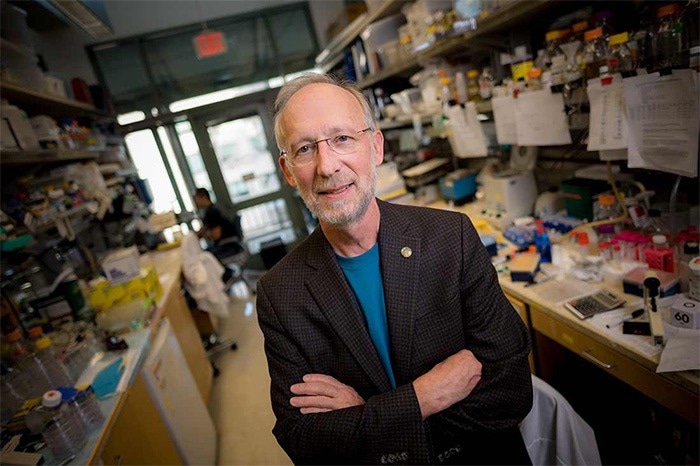A protein named TDP-43 has been lost from its normal location in the nucleus of the cell in virtually all persons having amyotrophic lateral sclerosis (ALS) and in up to half of all cases of frontotemporal dementia and Alzheimer’s disease (AD).
 Don Cleveland, PhD, Distinguished Professor of Medicine, Neurosciences and Cellular and Molecular Medicine at UC San Diego School of Medicine, is among the most highly cited researchers in the world for his work investigating neurodegenerative diseases. Image Credit: Erik Jepsen, UC San Diego.
Don Cleveland, PhD, Distinguished Professor of Medicine, Neurosciences and Cellular and Molecular Medicine at UC San Diego School of Medicine, is among the most highly cited researchers in the world for his work investigating neurodegenerative diseases. Image Credit: Erik Jepsen, UC San Diego.
Successively, this activates the loss of stathmin-2, a protein vital to the regeneration of neurons and the maintenance of their connections to muscle fibers, necessary for contraction and movement.
Having reported in the March 16th, 2023 issue of Science, a research group, headed by senior study author Don Cleveland, PhD, Distinguished Professor of Medicine, Neurosciences and Cellular and Molecular Medicine at the University of California San Diego School of Medicine, with collaborators and elsewhere, illustrate that stathmin-2 loss could be rescued with the help of designer DNA drugs that has the potential to restore normal processing of protein-encoding RNA.
With mouse models we engineered to misprocess their stathmin-2 encoding RNAs, like in these human diseases, we show that administration of one of these designer DNA drugs into the fluid that surrounds the brain and spinal cord restores normal stathmin-2 levels throughout the nervous system.”
Don Cleveland, PhD, Study Senior Author and Distinguished Professor of Medicine, Neurosciences and Cellular and Molecular Medicine, San Diego School of Medicine, University of California
Cleveland has been extensively credited for developing the idea of designer DNA drugs, which act to either turn on or turn off genes linked to several degenerative diseases of the aging human nervous system, such as AD, ALS, cancer, and Huntington’s disease.
At present, various designer DNA drugs are in clinical trials for several diseases. One such drug has been approved to treat a childhood neurodegenerative disease known as spinal muscular atrophy.
The new study constructs upon a continuing study by Cleveland and others concerning the role and loss of TDP-43, a protein linked to AD, ALS, and other neurodegenerative disorders. As far as ALS is concerned, TDP-43 loss affects the motor neurons that innervate and activate the contraction of skeletal muscles, thereby resulting in them degenerating and ultimately eventually leading to paralysis.
In almost all of instances of ALS, there is aggregation of TDP-43, a protein that functions in maturation of the RNA intermediates that encode many proteins. Reduced TDP-43 activity causes misassembly of the RNA-encoding stathmin-2, a protein required for maintenance of the connection of motor neurons to muscle.”
Don Cleveland, PhD, Study Senior Author and Distinguished Professor of Medicine, Neurosciences and Cellular and Molecular Medicine, San Diego School of Medicine, University of California
Cleveland added, “Without stathmin-2, motor neurons disconnect from muscle, driving paralysis that is characteristic of ALS. What we have now found is that we can mimic TDP-43 function with a designer DNA drug, thereby restoring correct stathmin-2 RNA and protein level in the mammalian nervous system.”
Particularly, the scientists edited genes in mice to contain human STMN2 gene sequences and further injected antisense oligonucleotides—small bits of DNA or RNA that have the potential to bind to specific RNA molecules. This blocks their potential to make a protein or alter how their final RNAs are arranged—into the cerebral spinal fluid.
The injections rectified STMN2 pre-mRNA misprocessing and restored stathmin-2 protein expression that has been completely independent of TDP-43 function.
Our findings lay the foundation for a clinical trial to delay paralysis in ALS by maintaining stathmin-2 protein levels in patients using our designer DNA drug.”
Don Cleveland, PhD, Study Senior Author and Distinguished Professor of Medicine, Neurosciences and Cellular and Molecular Medicine, San Diego School of Medicine, University of California
Source:
Journal reference:
Baughn, M. W., et al. (2023) Mechanism of STMN2 cryptic splice-polyadenylation and its correction for TDP-43 proteinopathies. Science. doi.org/10.1126/science.abq5622